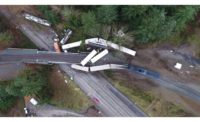The National Transportation Safety Board recently released conclusions of a preliminary investigation into a March 22 crash that killed six construction workers when an errant car sped through a work zone along the Interstate-695 Beltway in Baltimore.
The NTSB findings, released April 13, say that a 54-year-old woman driving a 2017 Acura TLX “traveled about 1.8 miles through the work zone” before striking a 2017 Volkswagen Jetta. The Acura, which was attempting to merge into the far-left lane, spun out of control through an opening in concrete barriers separating the work zone from the highway travel lanes.
“The opening was one of several access points designed to allow construction vehicles into the work zone,” the report says. “As the Acura traveled through the work zone, it struck miscellaneous construction materials and six of the workers before eventually coming to a stop after overturning.”
The report found that both cars were traveling in “excess” of the posted 55-mph speed limit “and greater than the speed of the adjacent traffic.”
It added that “all aspects of the crash remain under investigation while the NTSB determines the probable cause, with the intent of issuing safety recommendations to prevent similar events.”
The report says the work zone—which occupied both left shoulders of the Interstate—was part of a project along about 19 miles of I-695 between I-70 and Maryland State Highway 43.
The Acura driver was reportedly released after being transported to an area hospital with serious injuries. The 20-year-old male driver of the Volkswagen told police he was not injured, according to the NTSB report.
Raising Awareness
The document was released before the week-long National Stand-Down to Prevent Struck-by Incidents, organized in tandem with National Work Zone Awareness Week, observed April 17-21.
"The six deaths in Baltimore emphasize how keeping workers safe on the job depends on everyone—including the public," said Chris Cain, executive director of the Maryland-based nonprofit Center for Construction Research and Training, which helped organize the stand down.
"This is an excellent week for the construction industry to take a moment to participate in the National Stand-Down to Prevent Struck-by Incidents in coordination with National Work Zone Awareness week,” Cain added.
The center offers training resources to help contractors make work zones safer and also recently published a data bulletin providing “information on fatal and nonfatal Focus Four occupational injuries in construction, including by injury type and detailed event/exposure.”
National Work Zone Awareness week includes a series of events focused on improving safety for road construction workers and other vulnerable road users outside of vehicles, hosted by the U.S. Dept. of Transportation’s Federal Highway Administration.
U.S. DOT also is using the event to highlight several initiatives to increase work zone safety, including its National Roadway Safety Strategy, which it says is a “comprehensive approach to significantly reducing serious injuries and deaths on our nation’s roadways.”
The Biden administration’s infrastructure law includes several funding mechanisms to keep roadway construction crews safe, including $5 billion for local governments through the Safe Streets and Roads for All Discretionary Grant program, according to U.S. DOT. Another $15.6 billion in total funding is designed to help state DOTs improve work zone safety under the Highway Safety Improvement Program (HSIP).
Other programs in the infrastructure law to help state DOTs improve work zone safety include:
• Congestion Relief Program discretionary grants that can be used for deployment and operation of integrated congestion management systems, which must include work zone management.
• A Data Integration Pilot program for work zone data collection and traveler information activities.
• Federal funds apportioned to each state through HSIP that can currently be used for automated traffic enforcement system programs in a work zone.
"By working closely with our state and local partners we are bringing the investments of the bipartisan infrastructure law to bear in order to help save lives and strengthen the safety of those working in our nation's construction zones," Shailen Bhatt, the Federal Highway Administrator, said in a statement.
U.S. DOT also recently launched SMART discretionary grants funded by the infrastructure law that are intended to help state DOTs improve work zone safety, include a multistate effort to launch automated truck-mounted crash attenuators. The effort relies on the Work Zone Data Exchange Specification to address worker safety.
“We intend to use every program and funding option at our disposal under the bipartisan infrastructure law to make our surface transportation safer including in areas where repairs, maintenance and construction are underway,” Gloria Shepherd, Federal Highway Administration executive director, said during a kickoff event for National Work Zone Awareness week in Rocheport, Mo. “The safety of highway workers and others on roads, bridges and highways across the country is FHWA’s number one priority."





Post a comment to this article
Report Abusive Comment